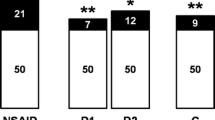Abstract
Pain from renal colic is often severe and incapacitating. Many patients require emergent hospitalization and aggressive analgesia to relieve such discomfort. For many years, the optimal analgesic strategy has been sought to manage such severe pain. One of the mainstays of therapy for acute renal colic is with non-steroidal anti-inflammatory drugs (NSAIDs). This paper reviews the mechanism by which NSAIDs allow pain relief in renal colic, the evidence for their use in this condition, and the use of NSAIDs combined with other agents in renal colic.
Similar content being viewed by others
References
Scales CD Jr, Smith AC, Hanley JM, et al. Prevalence of kidney stones in the United States. Eur Urol. 2012;62:160–5.
Smith-Bindman R, Aubin C, Bailitz J, et al. Ultrasonography versus computed tomography for suspected nephrolithiasis. N Engl J Med. 2014;371:1100–10.
Schug SA, Goddard C. Recent advances in the pharmacological management of acute and chronic pain. Ann Palliat Med. 2014;3:263–75.
Afshar K, Jafari S, Marks AJ, et al. Nonsteroidal anti-inflammatory drugs (NSAIDs) and non-opioids for acute renal colic. Cochrane Database Syst Rev. 2015;6:CD006027.
Graham A, Luber S, Wolfson AB. Urolithiasis in the emergency department. Emerg Med Clin North Am. 2011;29:519–38.
Shokeir AA. Renal colic: new concepts related to pathophysiology, diagnosis and treatment. Curr Opin Urol. 2002;12:263–9.
Travaglini F, Bartoletti R, Gacci M, et al. Pathophysiology of reno-ureteral colic. Urol Int. 2004;72(Suppl 1):20–3.
Holdgate A, Pollock T. Nonsteroidal anti-inflammatory drugs (NSAIDs) versus opioids for acute renal colic. Cochrane Database Syst Rev. 2004;1:CD004137.
Safdar B, Degutis LC, Landry K, et al. Intravenous morphine plus ketorolac is superior to either drug alone for treatment of acute renal colic. Ann Emerg Med. 2006;48:173–81 (181.e1).
Steinberg PL, Nangia AK, Curtis K. A standardized pain management protocol improves timeliness of analgesia among emergency department patients with renal colic. Qual Manag Health Care. 2011;20:30–6.
Harirforoosh S, Asghar W, Jamali F. Adverse effects of nonsteroidal antiinflammatory drugs: an update of gastrointestinal, cardiovascular and renal complications. J Pharm Pharm Sci. 2013;16:821–47.
Moore RA, Derry S, Aldington D, et al. Single dose oral analgesics for acute postoperative pain in adults—an overview of Cochrane reviews. Cochrane Database Syst Rev. 2015;9:CD008659.
Tielleman T, Bujanda D, Cryer B. Epidemiology and risk factors for upper gastrointestinal bleeding. Gastrointest Endosc Clin N Am. 2015;25:415–28.
The NAFARM Randomized Trial, Horbach SJ, Lopes RD, da C Guaragna JC, et al. Naproxen as prophylaxis against atrial fibrillation after cardiac surgery. Am J Med. 2011;124:1036–42.
Fosbol EL, Gislason GH, Jacobsen S, et al. Risk of myocardial infarction and death associated with the use of nonsteroidal anti-inflammatory drugs (NSAIDs) among healthy individuals: a nationwide cohort study. Clin Pharmacol Ther. 2009;85:190–7.
Author information
Authors and Affiliations
Corresponding author
Ethics declarations
Conflicts of interest
Dr. Steinberg and Dr. Chang have no relevant conflicts of interest, financial, employment, or otherwise, that are relevant to the publication of this manuscript.
Funding
There were no sources of funding for either the research or writing of this manuscript.
Rights and permissions
About this article
Cite this article
Steinberg, P.L., Chang, S.L. Pain Relief for Acute Urolithiasis: The Case for Non-Steroidal Anti-Inflammatory Drugs. Drugs 76, 993–997 (2016). https://doi.org/10.1007/s40265-016-0595-y
Published:
Issue Date:
DOI: https://doi.org/10.1007/s40265-016-0595-y




